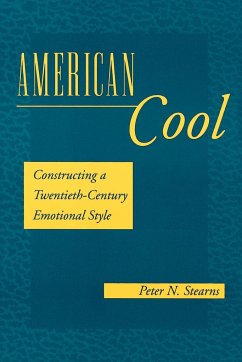"Richly and deeply documented, this history offers readers a chance to follow an intriguing problem: Can and should emotions be suppressed? Channeled? Expressed spontaneously? A major synthesis by one of the most innovative and accomplished historians of our time." --John Burnham, Ohio State University
"Peter Stearns argues that twentieth-century cultural styles stunt and stifle the emotions behind a veneer of cool. With a breathtaking scholarly sweep through the development of this concept of cool, he provokes and compels us to rethink our very understanding of the American character. Without a doubt, this is the best of Stearn's work on the history of emotions to date, and should be read by all who are concerned about the current crisis in American values." --Kevin White, University of Sussex
Cool. The concept, distinctly American, permeates almost every aspect of contemporary American society. From Kool cigarettes and the Peanuts cartoon's Joe Cool to "West Side Story" and urban slang, the idea of cool, in its many manifestations, has seized a central place in our vocabulary and in our culture.
Where did this preoccupation with cool come from? How was Victorian culture, seemingly so ensconced, replaced with the current emotional status quo? Whence came "American Cool"?
These are the questions Peter Stearns seeks to answer in this timely and engaging volume.
Cool. The concept has distinctly American qualities and it permeates almost every aspect of contemporary American culture. From Kool cigarettes and the Peanuts cartoon's Joe Cool to West Side Story (Keep cool, boy.) and urban slang (Be cool. Chill out.), the idea of cool, in its many manifestations, has seized a central place in our vocabulary. Where did this preoccupation with cool come from? How was Victorian culture, seemingly so ensconced, replaced with the current emotional status quo? From whence came American Cool? These are the questions Peter Stearns seeks to answer in this timely and engaging volume. American Cool focuses extensively on the transition decades, from the erosion of Victorianism in the 1920s to the solidification of a cool culture in the 1960s. Beyond describing the characteristics of the new directions and how they altered or amended earlier standards, the book seeks to explain why the change occurred. It then assesses some of the outcomes and longer-range consequences of this transformation.
"Peter Stearns argues that twentieth-century cultural styles stunt and stifle the emotions behind a veneer of cool. With a breathtaking scholarly sweep through the development of this concept of cool, he provokes and compels us to rethink our very understanding of the American character. Without a doubt, this is the best of Stearn's work on the history of emotions to date, and should be read by all who are concerned about the current crisis in American values." --Kevin White, University of Sussex
Cool. The concept, distinctly American, permeates almost every aspect of contemporary American society. From Kool cigarettes and the Peanuts cartoon's Joe Cool to "West Side Story" and urban slang, the idea of cool, in its many manifestations, has seized a central place in our vocabulary and in our culture.
Where did this preoccupation with cool come from? How was Victorian culture, seemingly so ensconced, replaced with the current emotional status quo? Whence came "American Cool"?
These are the questions Peter Stearns seeks to answer in this timely and engaging volume.
Cool. The concept has distinctly American qualities and it permeates almost every aspect of contemporary American culture. From Kool cigarettes and the Peanuts cartoon's Joe Cool to West Side Story (Keep cool, boy.) and urban slang (Be cool. Chill out.), the idea of cool, in its many manifestations, has seized a central place in our vocabulary. Where did this preoccupation with cool come from? How was Victorian culture, seemingly so ensconced, replaced with the current emotional status quo? From whence came American Cool? These are the questions Peter Stearns seeks to answer in this timely and engaging volume. American Cool focuses extensively on the transition decades, from the erosion of Victorianism in the 1920s to the solidification of a cool culture in the 1960s. Beyond describing the characteristics of the new directions and how they altered or amended earlier standards, the book seeks to explain why the change occurred. It then assesses some of the outcomes and longer-range consequences of this transformation.


